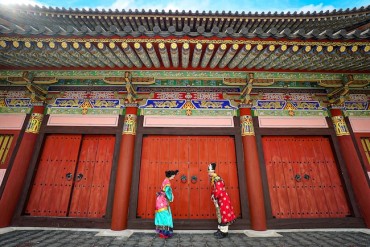The National Research Foundation of Korea announced on January 3 that a research team at Yonsei University had, through a manufacturing process making use of lower temperatures than normally required, successfully produced a hybrid solar cell of organic material and silicon. (Image: National Research Foundation of Korea)
DAEJEON, Jan 4 (Korea Bizwire) — The National Research Foundation of Korea announced on January 3 that a research team at Yonsei University had, through a manufacturing process making use of lower temperatures than normally required, successfully produced a hybrid solar cell of organic material and silicon.
Crystalline silicon solar cells are the most commonly used in today’s solar energy market, boasting an efficiency rate of 20 percent or higher and a long lifespan.
However, their disadvantages are a hefty price tag and a complex manufacturing process, which requires temperatures northward of 900 degrees Celsius.
Consequently, a significant amount of research is being conducted to overcome these obstacles, with one possible alternative to the crystalline silicon solar cells considered to be hybrids that make use of both silicon and organic material.
These hybrids are essentially crystalline silicon solar cells with a coating of organic material layered on top of the substrate.
The manufacturing process behind hybrid solar cells is both cheaper and simpler relative to 100 percent crystalline ones (manufacturing temperatures were sufficient at only 130 degrees Celsius).
The efficiency levels of the cells produced by the Yonsei researchers were measured at 17.3 percent, making their creation a high-efficiency, world-class product.
To maximize efficiency, the surfaces of the solar cells were organized into layers, reducing the amount of sunlight reflected off the surface and lost.

The efficiency levels of the cells produced by the Yonsei researchers were measured at 17.3 percent, making their creation a high-efficiency, world-class product. (Image: National Research Foundation of Korea)
By modifying the thickness of the organic material used as the coating, the researchers were able to prevent energy from seeping out.
From their work, the South Korean researchers were able to conclude that the hybrid solar cell’s efficiency could be improved to 18.5 percent.
Kang Dal-yong, one of the professors that headed the research project, said regarding the team’s work, “Instead of an expensive and complicated procedure, we employed a very simple process at low temperatures and improved a silicon and organic material hybrid solar cell’s efficiency level. Building on this research, it will possible to develop elastic solar panels that can bend and be stretched out.”
The research was funded by the Ministry of Education and the National Research Foundation of Korea.
S.B.W. (sbw266@koreabizwire.com)






